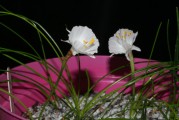The little pots of bulbs are still in my kitchen, as the temperature in the garage was 20F when last I checked. I’m keeping the house at 65F for the pots, and wearing an extra layer of clothes. Protect the pots at all cost. :-) A little trumpet seedling bloomed for the first time. It’s from ‘Little Gem’ op, and looks much like its parent. Nothing exciting like Harold’s minis, but at this point, a flower is a flower! There are also two blooms open in the pot of N. cantabricus. I keep hoping for a full pot of flowers, but consider myself lucky to get blooms at all.



What is most important Mary Lou is that you demonstrate that it does not take extraordinary effort to enjoy a pot with daffodils.
best
Harold
Mary Lou,
If Little Gem is a selected form of Narcissus minor then is 08 – 18 actually a bulb of Narcissus minor just showing a variation of the species?
Dave
Dave,
I guess that would be correct. Whether it’s an improvement or not is debatable.
Mary Lou
Are not all selections from species purely just that, variations from species and therefore should not be named as they are still species.
Malcolm
I think there are opinions on both sides of that question. But the RHS 2008 Register says, “Only the botanical taxa are classified in Division 13. Selections distinguished by a cultivar name, even if they were originally wild plants, are classified in one of Divisions 1 – 12.” So, if I ever wanted to exhibit it, it would go in Div. 1.
Mary Lou
“” Protect the pots at all cost. “”
“”
sounds like Colorado to me?
“”Are not all selections from species purely just that, variations from species and therefore should not be named as they are still species.””
Some of the hybridisers use variants of the species to hybridize- or cross- widely divergent types and subspecies, and some intercross the best of their clones-Malcolm- do you have a better wiay to identify these children than to name them?
John Beck
On the same naming species thought- if I self my asturiensis selections(selected and named by someone else) should I only exhibit any progeny as seedling selections or may I also exhibit them as species?
Going back to what the RHS says: “selections . . . even if they were originally wild plants, are classified in one of Divisions 1 – 12.” If you give your selection a number, it goes in the appropriate division. Don’t put it in Div. 13. I asked Ben Blake about searching in Daffseek for selections (which I couldn’t), and he did a SQL search and found 83 named cultivars that are selections of a species.
Mary Lou don’t you know we are not supposed to live in temperatures that low?? LOL
John Beck, Malcom, David, et al,
Genetically, selfed species are still species in their resulting offspring; species crossed with other flowers of the same species result in offspring of the same species; and species crossed with a different species result in hybrid offspring, thus are no longer the distinct species of either parent.
Selecting individual seedlings from selfed species grexes, groups, or strains (as varying plant societies recognize these offspring seedlings) will still perpetuate that species, albeit resulting in plants with traits deemed superior by the selector (larger, smaller, brighter, smoother, or more plentiful flowers, etc., than what the first generation exhibited). These unique selections, often referred to as clones, are generally given a name, like ‘Little Gem’, which basically means it is a superior selection from within the species. Giving that seedling selection a name does not make it any less of a species genetically; rather, it simply makes it a cultivar, thus marketable and able to be exhibited in a different class than the unselected wild species whence it was derived (N. minor).
Additional to daffodils, an incredible amount of plants in commerce around the globe that we think of as “hybrids” or “cultivars”, due to their having a cultivar name and due to their widespread marketing and publicity, are actually nothing more than superior clones selected from that species (much like ‘Little Gem’). Are they still a species? Genetically, yes, but since they have been given a registered name, they become recognized as cultivars. The word cultivar means very simply, “cultivated variety”; cultivar (and the word “variety”, which means a taxon or individual unique from others) does not have the same definition or meaning as hybrid, which means “the offspring of two different species or elements”. Once another species (or compatible hybrid with a varied genetic background) becomes involved in the breeding, then the offspring is no longer a species, but of a unique hybrid. I think this is where we often get confused how it’s possible for a species selection to receive a name, because we mentally assign the terms “cultivar” and “hybrid” the same definition, and because we “hybridize” our flowers… perhaps we should say we “self” or “cross” our flowers since, by definition, “hybridizing” means utilizing two distinct species or elements…. food for thought.
For me, naming species sections like ‘Little Gem’ is perfectly reasonable and should be widely accepted, provided there are good records to support its genetic history, or pedigree. And for those who breed and want to breed species characteristics, it should be acceptable to use such selections in doing so, provided the named cultivar is of pure species breeding. However, this notion evokes the wider argument of maintaining “purity” of the species; that is, after many successive generations of selfing the same species, and selecting the very best to use for perpetuating the next generation, we begin to muddle out the purity of original traits and the wildness of the species itself. For greater insight, I’ll leave this discussion for others more academically suited to explain. :-)
Best, Jason